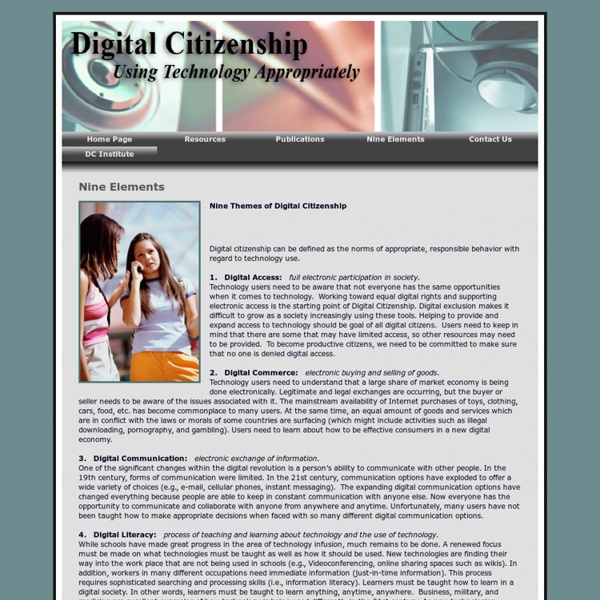Scope & Sequence: Common Sense K-12 Digital Citizenship Curriculum
Get Trained Use our professional development resources to learn best practices for teaching digital citizenship to your students. Onboard Students: Digital Passport Introduce students in grades 3-5 to Digital Passport, our award-winning suite of games that help onboard students to the foundational skills of digital citizenship and Internet safety. Teach Lessons: Unit 1 Teach Lessons: Unit 2
Digital Citizenship for 21st Century Learners « MITCHELLIUM
Digital Citizenship for 21st Century Learners Posted on Updated on During the 18th to 19th Century’s Industrial Revolution, machineries replaced many jobs in factories, and increased productivity. The same is true when computers where first plugged to revolutionize technology where some jobs shrink and eventually diminish, as new ones were and will be created because of the rise of the – DIGITAL AGE. It is pretty evident that the present world is run by technology. Merchants, right now, can be paid through phones where bank cards are connected to consumers’ Wechat money or Apple Pay accounts.
cyberwits
Welcome to a unit on Internet topics that will enlighten anyone that goes online. This unit requires you to go through 5 steps in order to fully appreciate the online culture. As the world continues to embrace the Internet as part of their normal routine, it is imperative that they make good choices and contribute positively to their communities and the world for that matter.
Teaching Students Good Digital Citizenship
Teachers have long understood the importance of instilling good citizenship in their students, focusing on social etiquette and how to treat their peers with respect in the course of their daily lives. Today, though, it’s just as important that students understand what kinds of behaviors are acceptable online. Instilling the principles of good digital citizenship can help students become smart, responsible, and respectful members of their online communities. What Is Digital Citizenship? We spend much of our lives today participating in virtual communities — like our social media networks, online forums, and even the comments sections of websites and blogs. Just as there are rules and norms that dictate what it means to be a good citizen in our real-life communities, there are ways to be a good “citizen” in the communities we interact with online.
What is Digital Citizenship?
Creating awareness of what students are creating and doing online. GUEST COLUMN | by Melissa Davis Digital citizenship is a hot topic amongst educators and district leaders these days. In the last few years, many districts, specifically those who’ve implemented 1-to-1 or BYOD policies, are being increasingly mandated to incorporate digital citizenship lessons into their curricula. But what exactly is digital citizenship?
Media Literacy: Five Ways Teachers Are Fighting Fake News
As the national attention to fake news and the debate over what to do about it continue, one place many are looking for solutions is in the classroom. Since a recent Stanford study showed that students at practically all grade levels can’t determine fake news from the real stuff, the push to teach media literacy has gained new momentum. The study showed that while students absorb media constantly, they often lack the critical thinking skills needed to tell fake news from the real stuff. Teachers are taking up the challenge to change that. NPR Ed put out a social media call asking how educators are teaching fake news and media literacy, and we got a lot of responses. Here’s a sampling from around the country:
Digital Citizenship and Social-Emotional Skills Are Inseparable
Every school has its own unique culture. It is made up of all the ways in which students relate to one another and their teachers. In today’s world, digital devices in particular (and technology in general) have a huge effect on these relationships. For better or worse, communication is different now, and it has the potential to make a big impact on your school’s culture. When I collaborate with schools, we often identify areas where a gap exists between what administrators, teachers, and parents believe students need to know, and what students actually know.
Thinkuknow - home
Watch Hector and his friends learning how to use their computers safely! Teacher's resources banner This cartoon and all the cool stuff with it comes to you with permission of the very nice people at Hector's World in New Zealand.
14 Digital Literacy Activities
Following a PD session I was involved with yesterday on creating Digital Literacies I have compiled 14 activities with both student and teacher guidance notes included focussing on four aspects of digital literacies. Still Images, Digital Sound, Moving Images and Digital Text. These activities are aimed at students from years 5 - 9 but you could easily adjust them to suit the needs of older and younger students. These activities can be set as either an independent task or as a whole class activity. Still Images




I like this because it summarizes for internet users safe practices. by latoyamalone Aug 31
Nine themes for a digital citizenship course - good summary by shellyw39 Jan 17